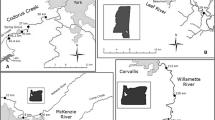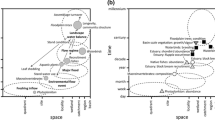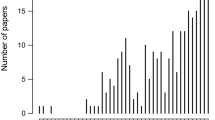Abstract
The spatial/temporal scaling problem (i.e., fitting a given research question to the dimensions of variability of the study area) is particularly pronounced in highly variable systems such as estuaries. Long-term, multidisciplinary studies in the Apalachicola Bay system were used to evaluate variation of different physical, chemical, and biological factors. Specific limitations of weekly, monthly, and quarterly sampling intervals were directly related to the efficiency of the sampling gear, the range of variation in the study parameters, and specific biological features (motility, recruitment, natural history) of infaunal macroinvertebrates and epibenthic organisms. There are families of spatial and temporal scaling phenomena that should be considered when establishing a given field sampling program. The dimensions of variation change along spatial/temporal gradients of salinity, habitat complexity, and productivity and among different levels of biological organization. The limits of variation define the needed sampling effort for a given level of estimation. Without an adequate evaluation of such variation, representative samples cannot be taken; the resulting inadequate sampling effort often precludes reliable comparisons and robust generalization. There is a continuum of scaling dimensions (and sampling problems) that ranges from small-scale experimental approaches to system-wide analyses. Misapplication of such scaling estimates has led to overgeneralization of experimental results. Currently, there is widespread misapplication of combinations of unrelated, limited sampling efforts to broad-scale resource problems. The loss of valuable estuarine resources is favored by the lack of adequate scientific databases that are consistent with the dimensions of the individual study areas. Unless experimental studies and field sampling programs are scaled to the dimensions of the research problem and the study area in question there will be a continued proliferation of trivial studies at one end of the continuum and the progressive deterioration of estuarine resources at the other.
Similar content being viewed by others

Literature Cited
Coull, B. C. 1985. The use of long-term biological data to generate testable hypotheses.Estuaries 8:84–92.
Cross, R. D., and D. L. Williams. 1981. Proceedings of the National Symposium on Freshwater Inflow to Estuaries. Volume 1. Fish and Wildlife Service, U.S. Department of Interior.
Dayton, P. K. 1979. Ecology: A science and a religion, p. 3–18.In R. J. Livingston (ed.), Ecological Processes in Coastal and Marine Systems. Plenum Press, New York and London.
Dayton, P. K. 1984. Processes structuring some marine communities: Are they general?, p. 181–197.In D. R. Strong, Jr. D. Simberloff, L. G. Abele, and A. B. Thistle (eds.), Ecological Communities: Conceptual Issues and the Evidence. Princeton University Press, New Jersey.
Dayton, P. K., V. Currie, T. Gerrodette, B. D. Keller, R. Rosenthal, andD. V. Tresca. 1984. Patch dynamics and stability of some California kelp communities.Ecol. Monogr. 54:253–289.
Diamond, J. M. 1976. Island biogeography and conservation: Strategy and limitations.Science 193:1027–1029.
Federle, T. W., R. J. Livingston, D. A. Meeter, andD. C. White. 1983a. Modifications of estuarine sedimentary microbiota by exclusion of epibenthic predators.J. Exp. Mar. Biol. Ecol. 73:81–94.
Federle, T. W., M. A. Hullar, R. J. Livingston, D. A. Meeter, andD. C. White. 1983b. Spatial distribution of biochemical parameters indicating biomass and community composition of microbial assemblies in estuarine mud flat sediments.App. Environ. Microbiol. 45:58–63.
Gilpin, M. E., andJ. M. Diamond. 1980. Subdivision of nature reserves and the mainternance of species diversity.Nature 285: 576–578.
Green, R. H. 1979. Sampling Design and Statistical Methods for Environmental Biologists. John Wiley & Sons. New York. 257 p.
Holland, A. F., andB. Kjerfve. 1985. Long-term estuarine and coastal data sets. Estuaries, Vol. 8, No. 2A. Estuarine Research Federation, Lawrence, Kansas. 96 p.
Jumars, P. A., D. Thistle, andM. L. Jones. 1977. Detecting two-dimensional spatial structure in biological data.Oecologia 28:109–123.
Livingston, R. J. 1976. Diurnal and seasonal fluctuations of estuarine organisms in a north Florida estuary: Sampling strategy, community structure, and species diversity.Estuarine Coastal Mar. Sci. 4:373–400.
Livingston, R. J. 1983. Resource Atlas of the Apalachicola Estuary. Florida Sea Grant College, Report No. 55, 64 p.
Livingston, R. J. 1984. The ecology of the Apalachicola Bay system: An estuarine profile. Report for National Coastal Ecosystems Team, U.S. Fish and Wildlife Service. 148 p.
Livingston, R. J. 1985. The relationship of physical factors and biological response in coastal seagrass meadows. Proc. Seagrass Symposium, Estuarine Research Foundation.Estuaries 7:377–390.
Livingston, R. J., R. J. Diaz, andD. C. White. 1985. Field validation of laboratory-derived multispecies aquatic test systems. Project Summary. U.S. Environmental Protection Agency. Gulf Breeze. 7 p.
Livingston, R. J. In press. Historic trends of human impacts on seagrass meadows in Florida. Florida Marine Research Publications, Florida Department of Natural Resources.
Livingston, R. J., andJ. Duncan. 1979. Short- and long-term effects of forestry operations on water quality and epibenthic assemblages of a north Florida estuary, p. 339–393.In R. J. Livingston (ed.), Ecological Processes in Coastal and Marine Systems. Plenum Press, New York.
Livingston, R. J., R. L. Iverson, R. H. Estabrook, V. E. Keys, andJ. Taylor, Jr. 1974. Major features of the Apalachicola Bay system: Physiography, biota, and resource management.Fla. Sci. 37:245–271.
Nichols, F. H. 1985. Abundance fluctuations among benthic invertebrates in two Pacific estuaries.Estuaries 8:136–144.
Orth, R. J., andK. A. Moore. 1984. Distribution and abundance of submerged aquatic vegetation in Chesapeake Bay: An historical perspective.Estuaries 7:531–540.
Simberloff, D. S., andL. G. Abele. 1976a. Island biogeography theory and conservation practice.Science 191:285–286.
Simberloff, D. S., andL. G. Abele. 1976b. Island biogeography and conservation: Strategy and limitations.Science 193: 1032.
Simberloff, D. S., andL. G. Abele. 1982. Refuge design and island biogeography theory: Effects of fragmentation.Am. Nat. 120:41–50.
Terbough, J. 1976. Island biogeography and conservation: Strategy and limitations.Science 193:1029–1030.
Underwood, A. J., andE. J. Denley. 1984. Paradigms, explanations, and generalizations in models for the structure of intertidal communities on rocky shores, p. 151–180.In D. R. Strong, D. Simberloff, L. G. Abele, and A. B. Thistle (eds.), Ecological Communities: Conceptual Issues and the Evidence, Princeton University Press, New Jersey.
U.S. Environmental Protection Agency. 1982. Chesapeake Bay Program Technical Studies: A Synthesis. Washington, D.C. 635 p.
Whitcomb, R. F., J. F. Lynch, P. A. Opler, andC. S. Robbins. 1976. Island biogeography and conservation: Strategy and limitations.Science 193:1030–1032.
Author information
Authors and Affiliations
Rights and permissions
About this article
Cite this article
Livingston, R.J. Field sampling in estuaries: The relationship of scale to variability. Estuaries 10, 194–207 (1987). https://doi.org/10.2307/1351848
Received:
Accepted:
Issue Date:
DOI: https://doi.org/10.2307/1351848



